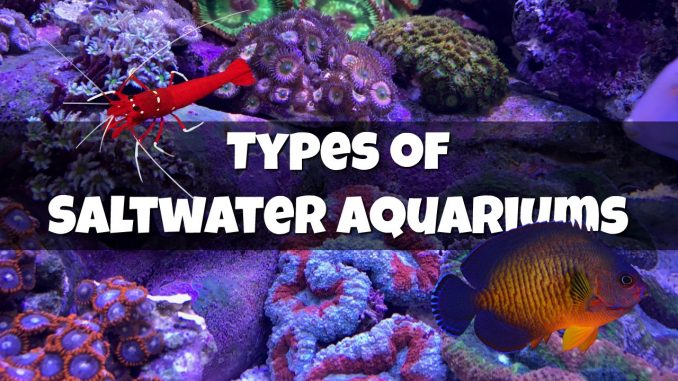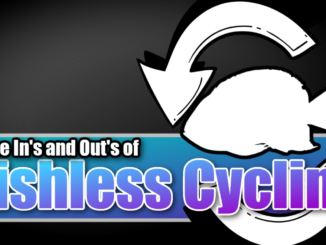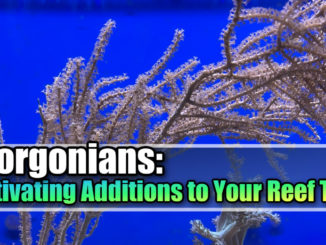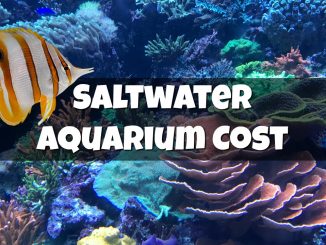
Types of Saltwater Aquariums
This is a general introduction into the three types of saltwater aquariums. There are three defined types of saltwater aquariums, that you my choose from. Each of them have their benefits and drawbacks, that should be considered before you decided which one is suitable for you. If you are looking to get into the saltwater aquarium hobby, take a monument to learn the basics about these saltwater aquarium setups you will be glade you did.
The three types of saltwater aquariums setups:
- Fish Only
- Fish Only with Live Rock (FOWLR)
- Coral Reef Tanks
Types of Saltwater Aquariums: Fish Only
This is a great setup for the saltwater aquarium fish lovers out there. As the name implies, this saltwater fish only tank setup is really for keeping fish only. You may be able to keep a few snails or hermit crabs to help control any algae problems. This is
This inherent difficulty is due to the lack of biological filtration. Nitrifying bacteria, which is a main player in the nitrogen cycle helps process the bio-load of the aquarium (fish waste). This
Getting started may take a little longer than the other setups while waiting for the nitrogen cycle to complete. Fish only systems also require more frequent aquarium maintenance than the other two saltwater aquarium types (in my opinion). This means that you will need to stay on top of those water changes to remove the nitrates that are constantly accumulating.
There are three types of fish only tanks:
- Community. The community tanks house species that will get along well with the other species in the tank. A good example of a community fish would be clownfish and tangs.
- Aggressive. The Aggressive tanks usually house predators of different species. Unless you have an extremely large tank, it is normally not recommended to get multiple fish from the same species. A good example of an aggressive fish would be triggers and eels.
- Non-reef safe. The Non-reef safe tanks house fish that are not considered reef safe because they are known coral nippers and or eaters. A good example of an Non-reef safe fish would be butterflyfish and some types of wrasses.
Fish Only Pros:
- Cost less.
- Can have non-reef safe fish.
Fish Only Cons:
- less effective biological filter.
- More aquarium maintenance.
- longer cycle time.
- Not newbie friendly
Just the same as any aquarium, regular water testing is necessary, You will need to periodically monitor the ammonia (NH3), nitrite (NO2), nitrate (NO3) and PH levels. These test readings will give you an indication of the water quality of your aquarium as well as what is needed for aquarium maintenance.
Types of Saltwater Aquariums: Fish Only With Live Rock (FOWLR)
A FOWLR setup bridges the gap between Fish Only and Coral Reef type aquariums. If you are undecided as to which type of saltwater aquarium you want, this is the smart choice for you. The major difference between Fish Only and FOWLR is the use of live rock as a form of aquascape and biologic filter.
The use of live rock
Live rock, can add substantial cost to the set up of a saltwater aquarium. Most hobbyist go by the general guideline of using 1 to 2 pounds of live rock per gallon of aquarium. High end live rock goes for $8 per pound. If you were starting a 55 gallon aquarium you would be looking at $450 – 600 just in live rock. This is if you made the decision to buy only High end live rock. There are money saving alternatives that can bring down the cost substantially, that I will cover another time.
There are three types of fish only with live rock tanks:
- Community. The community tanks house species that will get along well with the other species in the tank. A good example of a community fish would be clownfish and tangs.
- Aggressive. The Aggressive tanks usually house predators of different species. Unless you have an extremely large tank, it is normally not recommended to get multiple fish from the same species. A good example of an aggressive fish would be triggers and eels.
- Non-reef safe. The Non-reef safe tanks house fish that are not considered reef safe because they are known coral nippers and or eaters. A good example of an Non-reef safe fish would be butterflyfish and some types of wrasses.
Fish Only with Live Rock Pros:
- best biological filtration.
- Can have non-reef safe fish.
- Newbie friendly
Fish Only with Live Rock Cons:
- Higher cost (due to live rock).
Just the same as any aquarium, regular water testing is necessary, You will need to periodically monitor the ammonia (NH3), nitrite (NO2), nitrate (NO3) and PH levels. These water parameter test results, will give you an indication of the water quality of your aquarium as well as what is needed for aquarium maintenance.
Types of Saltwater Aquariums: Reef Aquarium
The reef aquarium is a system that is an enclosed ecosystem, in your home. Much of the livestock can sever a purpose and be mutually beneficial to the other inhabitants in the aquarium. Fish, invertebrates and corals living together can be a breath taking. Reef aquariums requires excellent husbandry, high water quality, strong aquarium lightingand excellent filtration (biological, mechanical, and chemical). These fish, invertebrates and corals can be very expensive and it can be hard to maintain all their individual requirements in one aquarium.
If you are just starting out in the saltwater aquarium hobby, you should consider maintaining a FOWLR aquarium before you take on the responsibility and care level of maintaining a fully stocked reef aquarium. Starting out with a FOWLR aquarium will help you learn the in and outs of the hobby and help you see if your up to the task of keeping and maintaining a reef aquarium.
Nano reef is a small aquarium (30 gallons or less) that is nothing but a scaled down reef aquarium. Many nano reef aquariums are beautiful works of art, but can be considered labor-some maintaining water quality.
There are two types of coral reef tanks:
- Community. The community tanks house species that will get along well with the other species in the tank. A good example of a community fish would be clownfish and tangs.
- Aggressive. The Aggressive tanks usually house predators of different species. Unless you have an extremely large tank, it is normally not recommended to get multiple fish from the same species. A good example of an aggressive fish would be triggers and eels.
Coral Reef Aquarium Pros:
- Reef aquariums are beautiful.
- Full ecosystem which can reduce maintenance over time.
- Corals can earn you money.
Coral Reef Aquarium Cons:
- High cost.
- Most aquarium maintenance out of the three types of saltwater aquariums.
- Not newbie friendly
Types of Saltwater Aquariums final thoughts.
It is our responsibility as hobbyist to inform ourselves (and others) about the proper care of the livestock, we keep in our aquariums as well as be an proactive representative of responsible reef keeping. We need to understand how the natural reefs have been affected by humans and support efforts to protect them.
My challenge to you, as you grow as a hobbyist is to simply inform yourself, educate others, buy aquacultured marine life
If you enjoyed our article or you are new to Mad Hatter’s Reef please take a moment to sign up for our FREE newsletter and like our Facebook page to stay up to date on all things related to saltwater aquariums.
Are you a Maine based hobbyist? Our retail store Corals Unlimited now offers Maine Aquarium Service to Central and Southern Maine




